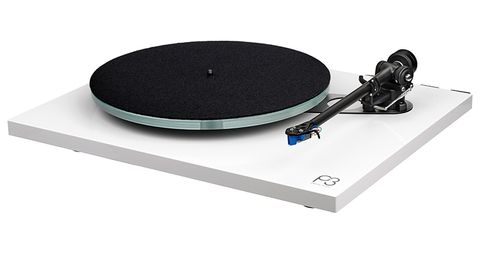Back in the early nineteen seventies, the main purveyors of turntables in Britain were Garrard and BSR, with the likes of Lenco, Dual, Philips, Collaro and Balfour also providing some popular designs. Many were auto-changers, and they were frequently featured in popular radiograms of the time; however, they were far from suitable for audiophile use. The Japanese were already encroaching on the market at this point, but it wasn’t until the Pioneer PL-12D came in 1973 that the cat fully got among the pigeons…
Whereas rim-drive designs like the Garrard SP25 mk4 were quite crude and noisy, the PL-12D was significantly more sophisticated, having a well-implemented belt drive mechanism that produced a respectable 47dB rumble figure. It was much quieter and smoother than the cheap Garrards of the time, and it sported a somewhat bigger twelve inch spinning zinc-alloy platter for greater disc support than the SP25’s ten inch pressed version.
A improved, longer 221mm S-shaped tonearm with SME-style removable headshell and well-adjusted radial bearings was also included. This was silkier to operate than the Garrard, had a lovely finish, and was equipped with an adjustable counterweight and an anti-skating system. It was also fully manual, as it was aimed at the budget audiophile market, which preferred lower friction bearings over automation; it had to be one or the other. In the UK, the slightly more expensive semi-automatic PL-12S variant was unpopular, demonstrating how much the manual version appealed to cash-strapped enthusiasts.
The Pioneer cost £55, compared to roughly £40 for a Garrard SP25. It was a world away from the British design, and it looked, felt, and sounded a million times better. Whereas the former struggled to track basic cartridges such as the Shure M75-6 (£8 in 1975), the latter’s arm was strong enough to handle the more expensive Shure M75ED2 (£12 in 1975), which had a far superior elliptical stylus and tracked at 0.75 to 1.5g, compared to the 3g that the Garrard’s M75-6 spherical tip ploughed the groove at. The deck and cartridge became a classic combination because to its lightweight arm, and the vast majority of these Pioneers were sold with it.
The motor is a four-pole AC synchronous motor, which means that the speed is fixed to the frequency of the mains and cannot be changed. As a result, the deck is configured to run slightly faster than the mains frequency to avoid the deck being too slow; it produces an acceptable wow and flutter number of 0.1 percent WRMS (the Linn LP12 of that time was 0.05 percent ). The full-sized (430x161x349mm, 7.5kg) deck comes with a dustcover and plinth – which, interestingly, were once optional extras for the SP25 – and is supported by springs that effectively isolate it from the outside world. Indeed, it outperforms its PL-112D replacement in this regard, which was not released at all. Foam rubber should be used to dampen these springs; if it has disintegrated in your case, you may always cut up a sponge and repair them!
The result is a fast-paced, bright, and vibrant sound that is also well-refined. The M75ED2 is a very forward cartridge – extremely dramatic sounding and a lot of fun – and the Pioneer is smooth enough to calm it down. It’s a little opaque and two-dimensional by today’s standards, but it’s still very listenable. Pioneer PL-12Ds are still quite simple to come by today, but they are starting to become collectible, therefore prices are rising. It’s still possible to find one for about £100, and it’s a terrific alternative to a modern entry-level Pro-Ject or Rega that has great classic cachet.
For almost three years, the PL-12D was the most popular turntable in the United Kingdom. The Trio KD-1033 appeared in 1977, delivering the same concept but with a somewhat better sound and a more current appearance, and was followed a year or two later by Sansui’s SR-222/II, which had an entirely more sophisticated design that made the Trio look antiquated. The Dual CS 506 from 1979, priced little under £90 in 1980, broke up the Japanese party; it was of far better quality and – in its cheaper CS505 form a year or two later – went on to dominate the eighties budget vinyl market until Compact Disc eventually triumphed.







